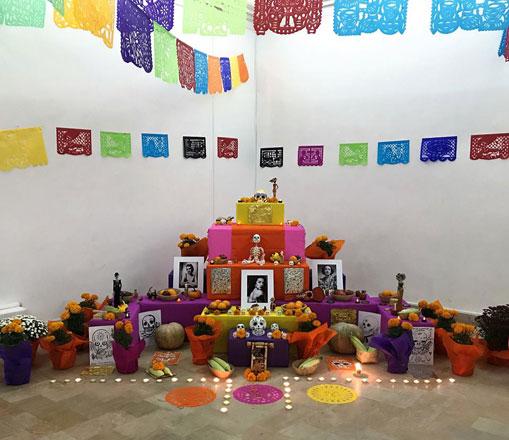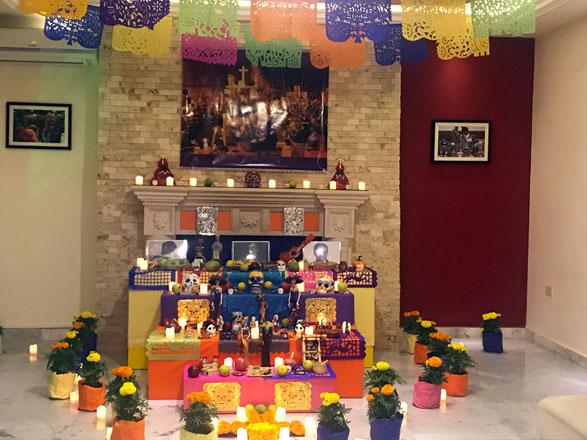You are here
Mexicans celebrate traditional ‘Day of the Dead’ in Amman
By Andrea Celeste - Nov 02,2017 - Last updated at Nov 02,2017

The Mexican embassy in Amman celebrated its third ‘Day of the Dead’ on Wednesday at the Cervantes Institute (Photo courtesy of the Mexican embassy Facebook page)
AMMAN — The Mexican embassy in Amman celebrated its third “Day of the Dead” on Wednesday at the Cervantes Institute, bringing an age-old and significant tradition to the Kingdom.
The Day of the Dead festivity goes back to pre-Hispanic era, which was later adopted by the Christians. It commemorates the symbolic return of dead loved ones to remember and honour them by building an “altar” and eating traditional Mexican food, according to a statement by the Mexican embassy.
“We believe it is a great opportunity to share with the Jordanian community a cultural tradition that is very much loved by Mexicans,” Mexican Ambassador Enrique Rojo Stein told to The Jordan Times at the event.
For the occasion, the embassy set up a colourful altar decorated with photos, food, flowers and memorabilia to commemorate three Mexican women with outstanding film careers during the 20th century.
“This year, to acknowledge the three talented women, we chose three important Mexican figures in the performing arts: Maria Felix, Lupita Tovar and Dolores del Rio, whose artistic and cultural work transcended borders,” the ambassador said.
Born in 1904, Dolores del Rio was the first Mexican movie star to gain international fame; she was associated with famous actor and Director El Indio Fernandez, and together they created “The Golden Era” of Mexican cinema during the 1940s and 1950s, he added.
Another artist commemorated was Lupita Tovar, who captivated Hollywood during the 1930s, she performed in “Santa”, the first Mexican movie which synchronised sound and image on the same celluloid strip in 1931. Her career included more than 30 motion pictures produced in Mexico and Hollywood.
The third honoured woman was renowned actress Maria Felix born in 1930, who was considered one of the “most beautiful film actresses of her time”. She made more than 50 films in Mexico, Spain, France, Italy and Argentina.
The altar was decorated with symbolic objects that carry special meaning in Mexican traditions; the “cempasuchitl” flower — an orange- coloured plant native to Mexico — guides the way for the dead. The candle lights accompany them through the tomb’s darkness, while the food nurtures them and signifies the importance of sharing food among family.
People from all over Amman, including members of Diplomatic Corps, attended the event. “This event to me is a continuation of what I have learned about Mexico and the values it represents. If we set apart religion and we consider civilisations, we can establish a peaceful, sweet and humanistic relationship,” Jabra Khoury, an honourary consul of Cuba said.
The attendees gathered to appreciate the traditional decorations, enjoyed food and refreshments, and watched a video on Mexico City’s second day of the dead parade, which was celebrated three days ago to commemorate the victims of Mexico City’s recent earthquake .
“This work is improving every year and we are happy to celebrate it; we hope this becomes a tradition in Jordan and it continues. To me, The Day of the Dead has a very special meaning” said Antonio Lazaro, director of the Cervantes Institute.
The Day of the Dead was recognised by UNESCO as an Intangible Cultural Heritage of Humanity in 2008, due to its profound cultural roots and current significance to Mexico and other Latin-American Countries, according to the statement.
Related Articles
AMMAN — The Mexican embassy in Amman held a reception on Sunday in honour of “Día De Los Muertos”, or the Day of the Dead, marking the comme
AMMAN — The embassy of Mexico, in partnership with Zaha Cultural Centre, on Wednesday inaugurated the “Little Mexican Board” as part of a ce
MEXICO CITY— Despite his international success, including a new adaptation of the classic puppet tale "Pinocchio", Oscar-winning Mexican dir














